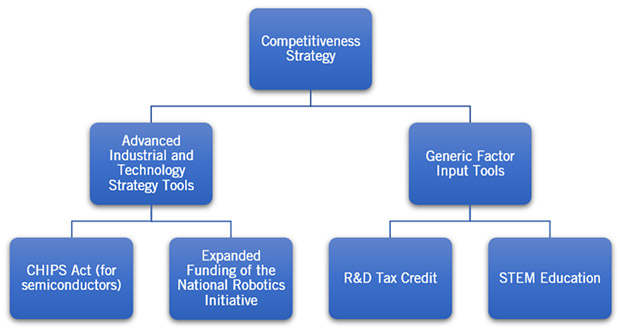If the United States wants to out-compete China in key technology markets, Congress and the Biden Administration must act now, maintained a Washington, D.C. think tank in a report released Monday.
“With the rise of China, the U.S. economic and technology environment has fundamentally and inexorably changed,” explained the report by the Information Technology & Innovation Foundation.
“America needs an advanced technology industrial policy to compete effectively,” it continued, “but that will require modernizing hidebound economic thinking that has long considered ‘industry policy’ to be anathema.”
The report called on government to take an active role in promoting industrial competitiveness and to formulate an advanced industry and technology strategy, which should include a set of policies and programs explicitly designed to support specific industries and technologies.
It recommended industries targeted by the policy meet four criteria:
- They must be ones that, without proactive government policy support, would underperform, either in general or because of foreign competition.
- The United States must have some potential for success in the industry or technology because of existing assets and strengths.
- Success in the industry or technology must be important to achieving key national goals, such as national defense and security, energy security and climate, a better trade balance, or faster productivity growth.
- The firms in the industry should want support and be willing to invest at least some of their own resources in the efforts.

One Chip Fits All
ITIF President Robert D. Atkinson, who authored the report, explained that governments engaging in industrial policy has been given a bad rap by economists.
“Economists believe the market does everything right,” he told TechNewsWorld. “What they focus on is allocation efficiency,” he continued. “So industrial policy is inherently bad because you are helping one industry over another. Potato chips or computer chips, every industry is equally important to them.”
“The notion that the government can’t do this is not born out by historical evidence in the U.S.,” he asserted. “The Internet alone would make up for any loses for the next 50 years.”
He explained that with industrial policy, the government is trying to invest in a sweet spot between areas the private sector won’t invest in because the risk is too high and areas so poor no one can make any money in them. “Government shouldn’t be substituting for the private sector, but it should be focusing on areas where the risk is a little higher and the payoff is higher,” he said.
“Government investments should yield big social benefits,” he continued. “We don’t expect the private sector to be thinking about social benefits. We don’t expect it to be thinking about U.S. competitiveness vis a vis China. It’s not their job. But it is the government’s job.”
Riddled with Failure
Doug Barry, senior director of communications and publications for the US-China Business Council, an organization of more than 200 American companies that do business with China, told TechNewsWorld that one argument against national industrial policies is that they’re less efficient than markets and lead to wasteful spending.
However, he added, “That argument does not give proper credit for massive government funding during the Sputnik era, which contributed to many important commercial applications such as the Internet, GPS, and the smartphone.”
One reason the United States has shied away from industrial policy is because of innovation in the private sector, observed Richard Stiennon, founder and chief research analyst at IT-Harvest, a cybersecurity industry analyst firm in Birmingham, Mich.
“There’s also another good reason not to have an industrial policy,” he told TechNewsWorld. “Governments are the least able to identify future growth areas. In 2007, for example, an industrial policy wouldn’t have predicted we were going to dominate the market in high-end cell phones.”
Industrial policy — where the government targets certain industries for non-market support in order to achieve commercial outcomes within national borders that could not be achieved without that support — has been riddled with failure throughout U.S. history, contended Scott Lincicome, a senior fellow at the Cato Institute, a public policy think tank in Washington, D.C.
“It doesn’t work in the United States due to a combination of the U.S. economic system having relatively liquid capital markets, which means the market is pretty good at picking winners and punishing losers, and our political system, which is characterized by high turnover and intense lobbying,” he told TechNewsWorld.
“Those two factors make industrial policy a pretty shoddy way to compete, regardless of what China is doing.”
R&D Credit
The industrial policy outlined in the ITIF report includes a doubling of the R&D tax credit. “We have a very low R&D tax credit compared to our competitors,” Atkinson said.
Lincicome noted, however, that private and public investment in R&D as a percentage of GDP just broke three percent for the first time and is growing.
“In terms of total dollars spent, we’re still the biggest spender on R&D in the world,” he said.
He also questioned the effectiveness of the R&D tax credit as a means of stimulating innovation.
“There’s pretty good evidence at this point that the R&D tax credit hasn’t really induced a real increase in R&D spending,” he observed. “Instead, companies have simply recharacterized spending as R&D to get the subsidy.”
“Any time you dangle a tax credit in front of a corporation,” he continued, “they’re going to hire some accountants to figure out how to be eligible for it.”
“The better move is to lower the corporate tax rate overall,” he added. “There’s a lot of good research that shows lower corporate tax rates tend to induce more R&D spending, patenting, and hiring of researchers.”
Strategy Needed
Even without an industrial policy, there are measures the United States can take to keep a leg up on China.
“In the short run, we can reform our immigration policies to enable more foreign students to work here after finishing their studies,” Barry recommended.
“Similarly,” he continued, “we can make it easier to attract the best STEM minds from other countries. And we can improve STEM education in our primary and secondary schools.”
“To make innovation more geographically dispersed, we can create technology innovation centers in different parts of the county,” he added.
“We know where to focus: AI, quantum computing, robotics, biotech, environmental technologies,” he said. “Whether or not it’s called industrial policy, the U.S. government needs to be more strategic in its thinking and action if we’re to avoid losing our competitive edge. Once lost, it will be very hard to regain it.”


























































Lies for idiots. China and the USA are not enemies, that is the illusion for the mask wearing zombie masses. In reality its all lies to bring in 1984